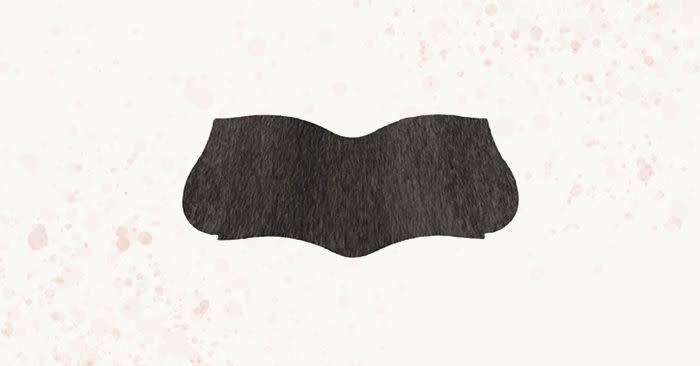Why Pore Strips Can Be Bad for Your Skin, According to Dermatologists
Plus, alternative treatments.

Byrdie
Fact checked by Anna HarrisReviewed by Julia A. Siegel, MD
We're all familiar with pore strips at this point—whether you grew up watching commercials of happy teenagers blissfully peeling off paper-like strips of their nose, were traumatized by the scene in "The Princess Diaries" where Mia quickly rips off her strip when her crush arrives, or you've tried them yourself. They've undeniably become a skincare staple in the past few decades, but they're often irritating peel-off feature has made many people question whether or not pore strips are actually safe for your skin.
They're often touted as a miracle quick-fix solution for removing blackheads as their adhesive sticks to damp skin, latches on to blackheads, and removes them as the strip gets peeled off. In theory, that sounds fine, but some believe doing this could actually make pores appear bigger than they already are. Furthermore, some say that using a pore strip may not be worth it as pores tend to fill up quickly. But if they're so popular, they can't be that bad, right?
We had the same question, so we tapped four dermatologists to give it to us straight. Below, they share everything you need to know about pore strips, including what to use as an alternative should you decide they're not for you.
Meet the Experts
Purvisha Patel, MD, is a board-certified dermatologist and founder of Visha Skincare.
Jennifer Herrmann, MD, is a board-certified dermatologist and dermatologic surgeon at MFC Dermatology in Beverly Hills.
Nava Greenfield, MD, is a dermatologist at Schweiger Dermatology Group in NYC.
Dendy Engelman, MD, is a board-certified dermatologic surgeon at Manhattan's Shafer Clinic.
How Do Pore Strips Work?
In theory, pore strips work to clean your pores by clinging to the buildup inside them. "Pore strips are strips of material with an adhesive on one side to adhere to and pull out open comedones or blackheads," Patel explains. "Blackheads happen when oil in the pores of the skin is exposed to air and oxidized, resulting in [a black appearance]. If the adhesive truly grabs the oil and pulls it out, voilá—the blackhead is taken out."
As far as their effectiveness, other dermatologists aren't so convinced. Patel continues, "The ability of the strip to adhere and clear the pores is a variable factor, and pore strips may not work for everyone, especially those that may have adhesive allergies." Herrmann adds, "Although they are marketed well, most aren't powerful enough to 'clean' pores."
Greenfield doesn't seem to think they're any more effective as a long-term solution, either. "I am not a fan of pore strips," Greenfield says. "They occasionally do a fair job at removing keratin buildup in pores, but the pores will fill right up again. The underlying issues, which are enlarged pores and overactive oil glands, are not addressed with the strips."
Are Pore Strips Bad for Your Skin?
Most pore strips are simply too strong for the skin, and end up removing or damaging the skin instead of just clearing your pores. For this reason, dermatologists don't recommend pore strips, especially if they contain drying additives like alcohol or other astringents.
"If they contain alcohol or other astringents, they can be irritating to sensitive skin," Herrmann says. Engelman cites another important piece of info to know about your pores: They don't open and close, so clearing them out won't make them physically "smaller"—in fact, by yanking away at a pore strip, you could be enlarging them. She explains, "I'm always wary of pore strips because while they [may] be fun, you risk damaging the skin and thus, [making] your pores bigger."
What to Use to Clear Your Pores Instead
While pore strips may "work" for you, the dangers outweigh the benefits. Instead, stick to a consistent, non-comedogenic, dermatologist-recommended skincare routine to keep pores clear.
Use a Cleanser With a Chemical Exfoliant
"Cleansing with a strong oil-busting wash that also exfoliates, is a more surefire way of eliminating blackheads," says Patel. This formula contains a combination of chemical exfoliators; salicylic acid (BHA) meant to exfoliate deep inside the pores, and glycolic acid (AHA) meant to slough away the dead cells on the skin's surface.
Use a Retinoid
Several of the dermatologists also recommend using retinoids to help sweep out pore-clogging debris. "I would recommend using something that addresses the underlying concern," says Greenfield. "For example, a retinoid cream can improve the appearance of the pores." Because retinoids are known to be irritating, this formula also contains bisabolol and Boswellia serrata extract meant to soothe skin and counteract the drying effects of the 1% retinol in this night cream.
Herrmann adds, "Using a retinoid or retinol can help reduce blockage more effectively and prevent acne." This over-the-counter retinoid cream is a dermatologist favorite for its effectiveness in reducing and preventing acne.
Try Professional Treatments
If you have a bit more to spend, try getting an in-office treatment. Herrmann recommends an Oxygeneo Facial, which oxygenates the skin from within, or a laser treatment like Clear + Brilliant, which she says will reduce the look of pores temporarily.
The Final Takeaway
While pore strips are a fun and satisfying way to unclog your pores, the dermatologists we consulted are not convinced they're worth the possible damage they can cause to the skin. Stick with other, safer–albeit slightly less exciting–methods when deep cleaning your pores for better results.
Up Next: The 12 Best Blackhead Removers of 2023, According to Dermatologists & Byrdie Editors
Read the original article on Byrdie.

